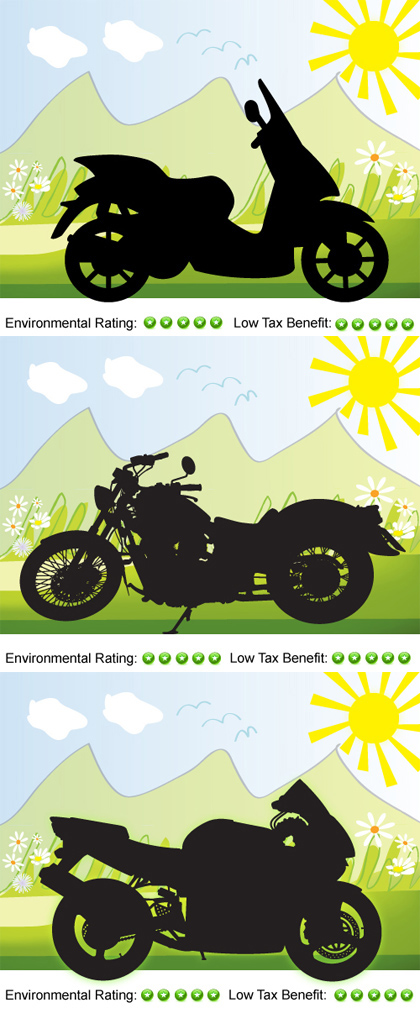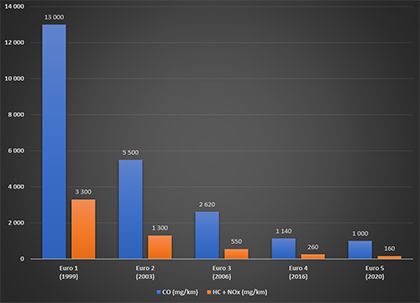 ACEM – European Association of Motorcycle Manufacturers – ACEM reported recently that as of the 1st January 2020, (just past) all new type-approved motorcycles and mopeds sold in the European Union (EU) and the European Free Trade Area (EFTA) will have to meet a new Euro 5 environmental standard, this will replace the current Euro 4 specification.
ACEM – European Association of Motorcycle Manufacturers – ACEM reported recently that as of the 1st January 2020, (just past) all new type-approved motorcycles and mopeds sold in the European Union (EU) and the European Free Trade Area (EFTA) will have to meet a new Euro 5 environmental standard, this will replace the current Euro 4 specification.
ACEM say that this brings the pollutant emissions of L-category vehicles (i.e. mopeds, motorcycles, tricycles and quadricycles) to the same level as Euro 6 cars.
Further stating that, “Technical innovation in the motorcycle industry has played a key role in progressively lowering vehicle emissions. Since the introduction of the Euro 1 standard for motorcycles and mopeds in 1999, pollutant emissions have been drastically reduced. Combined emissions of hydrocarbons (HC) and nitrogen oxides (NOx) have gone down by 96.6%, whilst carbon monoxide (CO) emissions have been reduced by 92.3%.”
“Some niche segments (i.e. enduro and trial motorcycles, three-wheeled mopeds designed for utility purposes and light quadrimobiles) have been granted additional lead time. These niche products will have to comply with the new Euro 5 tailpipe emissions limits as of 1 January 2024.”
“Durability provisions and evaporative emission levels are equally becoming more stringent. Another important innovation is the progressive introduction of a second stage on-board diagnostic (OBD), allowing advanced identification and flagging of malfunction and deterioration of emission control systems.”
Is this a surprise? The short answer is no.
The longer answer is that the collective of motorcyclists, their organised groups have been aware and have even been involved in the discussions and deliberations that motorcycles and moped are about to get cleaner in terms of emissions, as ACEM says, motorcycles and mopeds will be, “Improving environmental performance through vehicle technology.”
Discussions Afoot
Away back in 2009 discussions were afoot regarding proposals for a new European framework regulation for motorcycles to regulate emissions and the safety of motorcycles.
The framework regulation proposal entitled – Approval and market surveillance of two – or three-wheel vehicles and quadricycles – was published in 2010 by the European Commission, after many discussions, amendments and processes through the European Parliamentary Procedures, including the European Commission’s Motorcycle Working Group (MCWG) the proposal was debated and then approved by the European Parliament in 2012.
This regulation set up the introduction first of Euro4 emission standards through to where we ae now with the introduction of Euro 5 with discussions, amendments and processes with all interested parties.
Part of the regulation but into place that manufacturers had to declare the emissions, for the UK this meant that the motorcycle V5 (Vehicle Log Book) had to have the vehicle emissions stated, previous to this only some manufacturers were doing this.
It Was Tough – Older Bikes
 With emission zones being introduced in different countries, especially major cites and towns this was pertinent specifically for the introduction of London’s ULEZ (Ultra Low Emission Zone) by Transport for London (TFL) and the proposed daily charge of £12.50, which has now been introduced, for motorcycles and other vehicles that did not meet a certain level of “friendly” cleaner emissions then they have to pay this charge. Those that meet certain emission levels are exempt from the charge.
With emission zones being introduced in different countries, especially major cites and towns this was pertinent specifically for the introduction of London’s ULEZ (Ultra Low Emission Zone) by Transport for London (TFL) and the proposed daily charge of £12.50, which has now been introduced, for motorcycles and other vehicles that did not meet a certain level of “friendly” cleaner emissions then they have to pay this charge. Those that meet certain emission levels are exempt from the charge.
TFL originally stated that if the motorcycle was pre-Euro 3 emission standards (PTWs (Powered Two Wheelers) manufactured prior to 2007) they would incur the planned £12.50 charge but changed their focus to base emissions on the declared emissions of the vehicle rather than the age.
As a lot of pre Euro 3 motorcycles met the required emission levels, TFL stated that those motorcycles could be exempt from the charge. However not all motorcycles had emission level “proof” available e.g. stated in the vehicle log book. So riders with older bikes who could not afford or did not want to change their motorcycle to a newer model did not know if their bikes met the emission level unless they contacted the manufacturer for proof to give to TFL.
There was a problem with this route, apart from some manufacturers charging for this proof – CoC Certificate of Conformity – some manufacturers could not supply a Certificate of Conformity or rather the manufacturer could not state what the original emission level, in order to identify whether a pre Euro 3 PTW would be exempt from the emission charge.
A solution to this was the setting up of a test centre by Riverbank Motorcycles who at the time stated, “Many non‐Euro3 compliant bikes actually emit very low levels of NOx but many manufacturers didn’t start testing this until around 2001, making it tough for owners of older bikes to find out if their vehicle is eligible for ULEZ exemption … until now.
In the majority of cases, motorbikes that aren’t manufactured to Euro3 standards, can actually be set up so that the NOx emissions will comply with TfL standards.
The critical measure for ULEZ exemption is the vehicle’s Nitrogen Oxide (NOx) emissions, which must be equal to, or less than, 0.15 grams per kilometre. If an owner can provide Transport for London (TfL) with proof their motorbike complies with these measures, they will be exempt of the charge.
The strict test measures exhaust gas at idle, acceleration and deceleration and an average is taken. Like an M.O.T, it’s a pass / fail test. If a bike passes, results will be uploaded onto the TfL database and it will be classed as exempt. In cases where a bike fails, it might only take a small adjustment or maintenance, for that vehicle to then comply (some bikes though, won’t be able to meet the requirements). “
Of course riders have to pay for their bikes to be tested (£175) but would easily recoup that back in savings from not been charged for travelling in the ULEZ.
It must be said that London is not the UK and what path London chooses does not necessarily mean that others will follow, although London exempted motorcycles from their original congestion zone and still do, for example:
- Cardiff in Wales according to the Motorcycle Action Group (MAG), “ Proposals include a Congestion Charge which is expected to exempt motorcycles”.
- Low emission zones in Scotland under consultation.
- Bath in Somerset, no charges for motorcycles or private cars due to modelling, the new Liberal Democrat council took over from the Conservatives and carried out an independent review and a consultation.
- Exemption for motorcycles of all ages from Birmingham City Council’s Clean Air Zone (CAZ).
Banning the Internal Combustion Engine
Governments throughout Europe led by the European Commission analysis that no new diesel and petrol cars should be sold after 2040, have stated that there will be a ban on the sale of new petrol and diesel engine vehicles in their countries by certain dates.
The UK government have stated that this ban would be enacted in 2040, but then changed this to 2035, with some stating that they have been told this would not include motorcycles in 2035. The UK transport minister stated the ban could be earlier if possible.
The Motorcycle Action Group in the UK are campaigning against this ban on new vehicles with an Internal Combustion Engine, which the UK Government will be consulting on – Consulting on ending the sale of new petrol, diesel and hybrid cars and vans (consultation closes at 11:45pm on 29 May 2020) but states that – “The proposals relate to new cars and vans” no mention of motorcycles.
MAG’s Director of Campaigns & Political Engagement, Colin Brown, has stated, “We are pleased to hear that the ban from 2035 will not apply to the sale of petrol-powered motorcycles. Our membership consists overwhelmingly of petrol-engine bike users who do not wish to see the very thing they love banned. Yet it is clear, speaking to the Department that the threat remains. It will not surprise anyone that the debate over electrification is also taking place in MAG, with a range of views expressed. The task ahead is to plot a sensible, evidence-based approach in a subject area that ignites great passion and emotion.”
A Bit More from ACEM
Antonio Perlot, ACEM Secretary General, commented: “From a supply side perspective, vehicle technology has been instrumental in improving the environmental performance of motorcycles. ACEM members have invested heavily in research and product development to develop Euro 5 compliant motorcycles equipped with technologies such as 3-way catalysts with oxygen sensor controls, complex electronic engine management systems, advanced fuel injection and variable valve timing and lift technologies”.
“As a result of this, the environmental performance of Euro 5 motorcycles will be equivalent to that of Euro 6 cars. ACEM sees this fitting within the vision of the recent European Green Deal of achieving less polluting transport, especially in cities, and further enabling the contribution of our range of vehicles to a multimodal transport system”.
De-modifying Emissions
As emissions reduce on motorcycles or as some riders see this as emission restrictions increasing, our engines are being modified at the point of manufacture, so are we getting the new bikes that we want or are we just being given the new bikes that are required under rules and regulation?
If we are and we are, then as we know, no man or woman’s motorcycle ever stays the same as when it is purchased.
We have engines that are built for the emissions required, linked with environmentally friendly reductions, but have the potential to become modified by riders or rather they are being de-modified by them to make the engine be what it should be (according to the owner).
This is not necessarily, as has been in the past, for increased performance related to speed but for power delivery, tractability and just proper throttle response. e.g. free flowing air filters – electronic modification mapping – carburettor changes/adjustments – full exhaust changes (within noise limits) – removal of emission systems.
As has been seen from requirements to test motorcycles to exempt them from emission charging in London, previous Euro emission levels will pass emission requirements even with some adjustments.
The $64,000 question to ask is : would de-modifying emission reductions – environmental performance through vehicle technology – on motorcycles be that bad?
Original Sources – Information – ACEM New Euro 5 environmental standard for motorcycles and mopeds to enter into force in 2020 – Directives and regulations – two- and three-wheel vehicles and quadricycles – MAG ICE Vehicles


HI paid 175 pounds honda c90 2001 asked the mayor london money back no so have to go to the TFL is the only person to get the money back, send the pass and waiting for a reply two times. thanking you .
HI i paid 175 pounds honda c90 club 2001 asked mayor london refund did not want to no its down to TFL so IVE SENT THE PASS 3 MORTHS ago SEND A UP DATE STILL WAITING i want the money back 175 pounds.GET IT BACK FROM TFL ONLY. ITS A BIG CON..